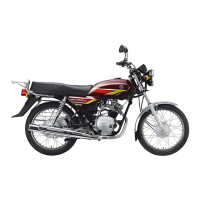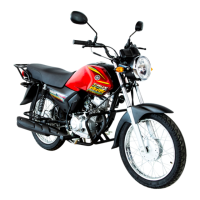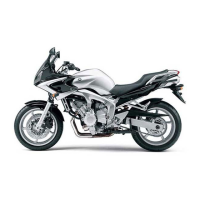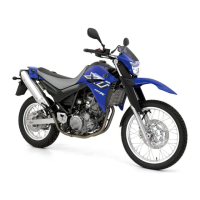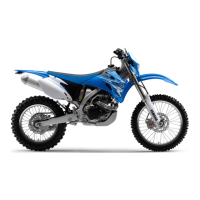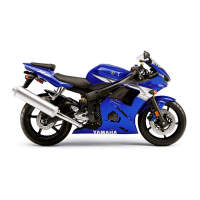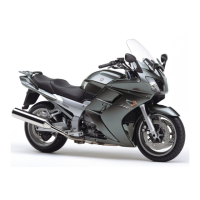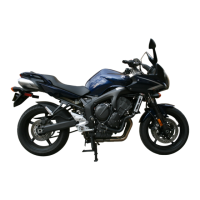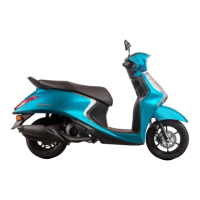Do you have a question about the Yamaha Crux S and is the answer not in the manual?
Learn proper motorcycle riding techniques and control functions for safe operation.
Learn and apply effective basic methods for safe braking techniques.
Identification and description of motorcycle parts visible from the left side.
Identification and description of motorcycle parts visible from the right side.
Identification and explanation of motorcycle controls and instrument panel features.
Displays riding speed and records total distance traveled.
Explains the function of various indicator lights on the instrument panel.
Operation and function of handlebar-mounted switches like dimmer, lights, horn, and turn signals.
Location and operation of the clutch lever for engaging/disengaging the clutch.
Location and operation of the shift pedal for changing gears.
Location and operation of front and rear brake levers/pedals.
Instructions for opening and closing the fuel tank cap.
Guidance on checking and filling the fuel tank with the correct type and amount of fuel.
Operation of the fuel cock lever for fuel flow control (OFF, ON, RES).
Operation of the choke lever for starting cold engines.
Procedure for using the kick starter to start the engine.
Instructions for opening and removing the motorcycle seat.
Location and description of the storage compartment.
Information about the rear shock absorber type.
Identification of the handle seat.
Identification of the stay lock for helmet mounting.
Step-by-step procedure for starting and warming up a cold engine.
Procedure for starting a warm engine, noting when choke may not be required.
Explanation of how the transmission controls power and the use of the shift pedal.
Advice on how to improve motorcycle fuel efficiency through riding habits.
Essential procedures and precautions for the engine's initial break-in period (0-1000 km).
Information about the owner's tool kit and other necessary tools for maintenance.
Procedures for removing and reinstalling motorcycle panels for maintenance access.
Procedures for removing and reinstalling motorcycle panels (Panel A and B).
Guide to inspecting the spark plug condition and its role in engine performance.
Instructions for checking and maintaining the engine oil level for optimal performance and life.
Step-by-step procedure for changing the engine oil and filter.
Instructions for cleaning and maintaining the air filter element.
Procedures for adjusting carburetor settings and idle speed.
How to adjust the free play in the throttle cable for proper operation.
Explanation of valve clearance and the need for regular adjustment by a dealer.
Guidelines for ensuring maximum performance, service life, and safe operation of tires.
Routine checks for tire wear, damage, and proper inflation.
Guidelines for inspecting wheels for damage, loose spokes, and proper maintenance.
Procedure for adjusting the free play in the clutch lever.
Procedure for adjusting the free play in the front brake lever.
Procedure for adjusting the free play in the rear brake pedal and checking the brake light.
How to adjust the rear brake light switch for proper activation.
How to inspect brake shoes for wear using the indicator.
Procedure for checking and adjusting the drive chain slack.
Detailed steps for adjusting the drive chain slack and alignment.
Instructions for cleaning and lubricating the drive chain.
Procedures for inspecting and lubricating control cables.
How to lubricate the throttle cable and grip assembly.
Lubrication of brake/shift pedals, clutch levers, and center/sidestands.
Steps for inspecting the front fork for damage, oil leaks, and smooth operation.
How to inspect steering for smooth movement, loose bearings, and proper adjustment.
How to inspect wheel bearings for play or smooth rotation.
Instructions for checking battery electrolyte level and terminal tightness.
Procedures for storing the battery properly during long-term non-use.
How to locate and replace a blown fuse.
Step-by-step guide to replacing the headlight bulb.
Procedure for replacing turn signal and taillight bulbs.
Steps for safely removing the front wheel.
Steps for correctly installing the front wheel.
Steps for safely removing the rear wheel.
Steps for correctly installing the rear wheel.
Warnings regarding improper cleaning methods and the use of cleaning products.
Procedures for long-term storage of the motorcycle, including battery and fuel preparation.
Importance of headlights, taillights, indicators, and mirrors for visibility and signaling.
Proper operation of brakes and clutch for safe control.
Features like horn, helmet lock, and pillion grip for rider safety.
Specifies the warranty period based on kilometers or time from purchase/previous service.
Conditions and exclusions that void the warranty.
Inspection points related to the motorcycle's frame and its components.
Inspection points for tires, rims, spokes, and locks.
Torque specifications for various fasteners on the motorcycle.
Inspection points related to the engine, including oil and spark plug.
Inspection and settings for spark plug and valve clearance.
Checking kick starter operation and carburetor settings.
Checking drive chain alignment/slackness and fastener torque specs.
Inspection of electrical systems, including ignition, lights, battery, and fuse.
Checks to be performed during a road test for proper motorcycle operation.
Explanation of essential operations and checks for the customer at delivery.
Guidelines for owners/users regarding government regulations and environmental protection.
Lists components that affect the motorcycle's emission levels.
Learn proper motorcycle riding techniques and control functions for safe operation.
Learn and apply effective basic methods for safe braking techniques.
Identification and description of motorcycle parts visible from the left side.
Identification and description of motorcycle parts visible from the right side.
Identification and explanation of motorcycle controls and instrument panel features.
Displays riding speed and records total distance traveled.
Explains the function of various indicator lights on the instrument panel.
Operation and function of handlebar-mounted switches like dimmer, lights, horn, and turn signals.
Location and operation of the clutch lever for engaging/disengaging the clutch.
Location and operation of the shift pedal for changing gears.
Location and operation of front and rear brake levers/pedals.
Instructions for opening and closing the fuel tank cap.
Guidance on checking and filling the fuel tank with the correct type and amount of fuel.
Operation of the fuel cock lever for fuel flow control (OFF, ON, RES).
Operation of the choke lever for starting cold engines.
Procedure for using the kick starter to start the engine.
Instructions for opening and removing the motorcycle seat.
Location and description of the storage compartment.
Information about the rear shock absorber type.
Identification of the handle seat.
Identification of the stay lock for helmet mounting.
Step-by-step procedure for starting and warming up a cold engine.
Procedure for starting a warm engine, noting when choke may not be required.
Explanation of how the transmission controls power and the use of the shift pedal.
Advice on how to improve motorcycle fuel efficiency through riding habits.
Essential procedures and precautions for the engine's initial break-in period (0-1000 km).
Information about the owner's tool kit and other necessary tools for maintenance.
Procedures for removing and reinstalling motorcycle panels for maintenance access.
Procedures for removing and reinstalling motorcycle panels (Panel A and B).
Guide to inspecting the spark plug condition and its role in engine performance.
Instructions for checking and maintaining the engine oil level for optimal performance and life.
Step-by-step procedure for changing the engine oil and filter.
Instructions for cleaning and maintaining the air filter element.
Procedures for adjusting carburetor settings and idle speed.
How to adjust the free play in the throttle cable for proper operation.
Explanation of valve clearance and the need for regular adjustment by a dealer.
Guidelines for ensuring maximum performance, service life, and safe operation of tires.
Routine checks for tire wear, damage, and proper inflation.
Guidelines for inspecting wheels for damage, loose spokes, and proper maintenance.
Procedure for adjusting the free play in the clutch lever.
Procedure for adjusting the free play in the front brake lever.
Procedure for adjusting the free play in the rear brake pedal and checking the brake light.
How to adjust the rear brake light switch for proper activation.
How to inspect brake shoes for wear using the indicator.
Procedure for checking and adjusting the drive chain slack.
Detailed steps for adjusting the drive chain slack and alignment.
Instructions for cleaning and lubricating the drive chain.
Procedures for inspecting and lubricating control cables.
How to lubricate the throttle cable and grip assembly.
Lubrication of brake/shift pedals, clutch levers, and center/sidestands.
Steps for inspecting the front fork for damage, oil leaks, and smooth operation.
How to inspect steering for smooth movement, loose bearings, and proper adjustment.
How to inspect wheel bearings for play or smooth rotation.
Instructions for checking battery electrolyte level and terminal tightness.
Procedures for storing the battery properly during long-term non-use.
How to locate and replace a blown fuse.
Step-by-step guide to replacing the headlight bulb.
Procedure for replacing turn signal and taillight bulbs.
Steps for safely removing the front wheel.
Steps for correctly installing the front wheel.
Steps for safely removing the rear wheel.
Steps for correctly installing the rear wheel.
Warnings regarding improper cleaning methods and the use of cleaning products.
Procedures for long-term storage of the motorcycle, including battery and fuel preparation.
Importance of headlights, taillights, indicators, and mirrors for visibility and signaling.
Proper operation of brakes and clutch for safe control.
Features like horn, helmet lock, and pillion grip for rider safety.
Specifies the warranty period based on kilometers or time from purchase/previous service.
Conditions and exclusions that void the warranty.
Inspection points related to the motorcycle's frame and its components.
Inspection points for tires, rims, spokes, and locks.
Torque specifications for various fasteners on the motorcycle.
Inspection points related to the engine, including oil and spark plug.
Inspection and settings for spark plug and valve clearance.
Checking kick starter operation and carburetor settings.
Checking drive chain alignment/slackness and fastener torque specs.
Inspection of electrical systems, including ignition, lights, battery, and fuse.
Checks to be performed during a road test for proper motorcycle operation.
Explanation of essential operations and checks for the customer at delivery.
Guidelines for owners/users regarding government regulations and environmental protection.
Lists components that affect the motorcycle's emission levels.
| Brand | Yamaha |
|---|---|
| Model | Crux S |
| Category | Motorcycle |
| Language | English |
